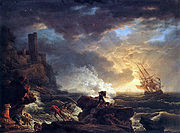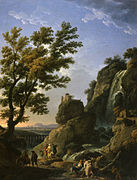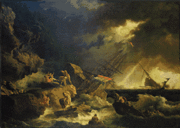Claude-Joseph Vernet: Difference between revisions
m →Life and work: First reference (Wallace collection) link broken, replaced with National Gallery. |
Smirnoff 80 (talk | contribs) |
||
| Line 34: | Line 34: | ||
Image:Vernet, Claude Joseph - The Shipwreck - 1772.jpg|''The Shipwreck'' (1772), [[National Gallery of Art]], [[Washington D.C]] |
Image:Vernet, Claude Joseph - The Shipwreck - 1772.jpg|''The Shipwreck'' (1772), [[National Gallery of Art]], [[Washington D.C]] |
||
Image:Vernet Morning.jpg|''The Morning'' (1774), [[National Museum, Warsaw|National Museum]], [[Warsaw]] |
Image:Vernet Morning.jpg|''The Morning'' (1774), [[National Museum, Warsaw|National Museum]], [[Warsaw]] |
||
File:Claude Joseph Vernet, A Storm in the Sea.gif|"A Storm in the Sea" (1770-80s), [[Museum of Western and Oriental Art]], [[Kiev]] |
|||
Image:J. Vernet (engraving by P. Ozann).jpg|''Fishermen caught by the wind'' (1770-80s). Private collection, Russia |
Image:J. Vernet (engraving by P. Ozann).jpg|''Fishermen caught by the wind'' (1770-80s). Private collection, Russia |
||
</gallery> |
</gallery> |
||
Revision as of 17:14, 6 November 2013
Claude Joseph Vernet | |
|---|---|
 Joseph Vernet, by Élisabeth Vigée-Lebrun | |
| Born | 14 August 1714 |
| Died | 3 December 1789 (aged 75) |
| Nationality | French |
| Known for | Painting |
Claude-Joseph Vernet (14 August 1714 – 3 December 1789) was a French painter. His son, Antoine Charles Horace Vernet, was also a painter.
Life and work
Vernet was born in Avignon. When only fourteen years of age he aided his father, Antoine Vernet (1689–1753),[1] a skilled decorative painter, in the most important parts of his work. The panels of sedan chairs, however, could not satisfy his ambition, and Vernet started for Rome. The sight of the sea at Marseilles and his voyage thence to Civitavecchia (Papal States' main port on the Tyrrhenian Sea) made a deep impression on him, and immediately after his arrival he entered the studio of a marine painter, Bernardino Fergioni.
Slowly Vernet attracted notice in the artistic milieu of Rome. With a certain conventionality in design, proper to his day, he allied the results of constant and honest observation of natural effects of atmosphere, which he rendered with unusual pictorial art. Perhaps no painter of landscapes or sea-pieces has ever made the human figure so completely a part of the scene depicted or so important a factor in his design. In this respect he was heavily influenced by Giovanni Paolo Panini, whom he probably met and worked with in Rome. Vernet's work draws on natural themes, but in a way that is neither sentimental or emotive. The overall effect of his style is wholly decorative.[2] "Others may know better", he said, with just pride, "how to paint the sky, the earth, the ocean; no one knows better than I how to paint a picture". His style remained relatively static throughout his life. His works' attentiveness to atmospheric effects is combined with a sense of harmony that is reminiscent of Claude Lorrain.
For twenty years Vernet lived in Rome, producing views of seaports, storms, calms, moonlights, becoming especially popular with English aristocrats, many of whom were on the Grand Tour. In 1745 he married an Englishwoman whom he met in the city. In 1753 he was recalled to Paris: there, by royal command, he executed the series of the seaports of France (now in the Louvre and the Musée national de la Marine) by which he is best known.[2] His The Port of Rochefort (1763, Musée national de la Marine) is particularly notable; in the piece Vernet is able to achieve, according to art historian Michael Levey, one of his most 'crystalline and atmospherically sensitive skies'. Vernet has attempted to bring the foreground of his work to life through painting a wide array of figures engaging in a variety of activities, endeavouring to convey a sense of the commotion and drama of France's seaports. Throughout his life Vernet returned to Italian themes, as shown through one of his later works - A Seashore (National Gallery).[2] On his return from Rome he became a member of the academy, but he had previously contributed to the exhibitions of 1746 and following years, and he continued to exhibit, with rare exceptions, down to the date of his death, which took place in his lodgings in the Louvre on the 3rd of December 1789. Amongst the very numerous engravers of his works may be specially cited Le Bas, Cochin, Basan, Duret, Flipart and Le Veau in France, and in England Vivares.
Gallery
-
Shipwreck (1759), Groeninge Museum, Bruges
-
La Rochelle harbour in 1762, Musée de la Marine
-
Sebastião José de Carvalho e Melo, Marquis of Pombal, The Expulsion of the Jesuits (1767), Museu da Cidade de Lisboa
-
Landscape with Waterfall and Figures (1768). The Walters Art Museum.
-
The Shipwreck (1772), National Gallery of Art, Washington D.C
-
The Morning (1774), National Museum, Warsaw
-
"A Storm in the Sea" (1770-80s), Museum of Western and Oriental Art, Kiev
-
Fishermen caught by the wind (1770-80s). Private collection, Russia
Literary references
In Arthur Conan Doyle's short story "The Adventure of the Greek Interpreter", fictional detective Sherlock Holmes claims that his grandmother is Vernet's sister, without stating whether this is Claude Joseph or Antoine Charles Horace's sister.
References
- ^ Claude-Joseph Vernet (National Gallery).
- ^ a b c Michael Levey. Painting and Sculpture in France, 1700-1789. Yale University Press.
This article incorporates text from a publication now in the public domain: Chisholm, Hugh, ed. (1911). "Vernet". Encyclopædia Britannica. Vol. 27 (11th ed.). Cambridge University Press. p. 1030.
External links
- Life and works of Vernet (Théodore Gégoux art gallery)
- C. J. Vernet online (Artcyclopedia)








